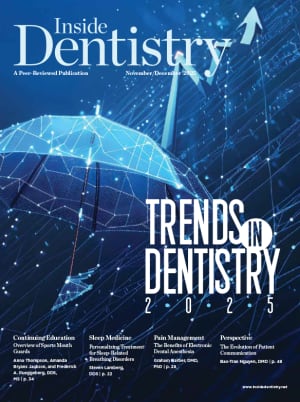A study has identified a potential association between periodontal disease and cerebral small vessel disease.
Patients with cerebral small vessel disease—assessed via radiographic measures of white matter hyperintensity, cerebral microbleeds, and lacunar infarcts—are at increased risk of cognitive decline, depression, dementia, and ischemic and hemorrhagic stroke. Although the condition is progressive and is thought to be caused by age-related vessel wall weakening, hypertension, and diabetes, researchers are still uncertain of the pathogenesis of cerebral small vessel disease.
Periodontal disease is a prevalent oral disease estimated to be present in 70.1% of all adults aged 65 years and older. Patients with chronic diseases such as diabetes, a smoking history, and poor oral hygiene are more likely to develop periodontal disease. Further, prior research has indicated that patients with periodontal disease may be more susceptible to cardiovascular disease.
In a study published in Neurology Open Access, researchers examined the relationship between periodontal disease and biomarkers of cerebral small vessel disease among 1,143 patients with a mean age of 77 years who participated in the Atherosclerosis Risk in Communities cohort. The study involved a comprehensive periodontal assessment with full-mouth clinical periodontal measurements at Visit 4 (1996-1998) and brain magnetic resonance imaging (MRI) at Visit 5 (2011-2013), with a median interval of 14.8 years between assessments. The researchers sed fluid-attenuated inversion recovery images to evaluate white matter hyperintensity volume as percentages of intracranial volume and segment the results into four quartiles for statistical analysis.
Among the patients, the researchers identified 800 who had periodontal disease and 343 who were periodontally healthy. There were no statistically significant differences in blood pressure, low-density lipoprotein cholesterol levels, total cholesterol levels, or triglycerides between both groups. Compared with those who were periodontally healthy, the participants with periodontal disease had greater white matter hyperintensity volumes (median percentage:2.83 vs 2.52) and a higher quartile (Q4 > 21.36 cm3). The association between the fourth quartile of white matter hyperintensity volume and periodontal disease had a crude odds ratio (OR) of 1.77 (95% confidence interval [CI] = 1.23–2.56) and an OR of 1.56 (95% CI = 1.01–2.40) after adjusting for age, race, sex, hypertension, diabetes, smoking status, and time between periodontal assessment and MRI. There were no statistically significant associations between periodontal disease and cerebral microbleeds (adjusted OR = 1.16, 95% CI = 0.83–1.63) or lacunar infarcts (adjusted OR = 1.14, 95% CI = 0.77–1.69) following adjustment, suggesting confounding demographic and vascular risk factors responsible for the initial association.
The researchers hypothesized that the systemic inflammation characteristic of periodontal disease could contribute to the development of cerebral small vessel disease. Study limitations include the substantial temporal gap between dental and imaging assessments and potential residual confounding inherent in observational studies. The results of the study could lead to targeted interventions to reduce the risk of cerebral small vessel disease by enhancing oral hygiene and mitigating periodontal disease.
Source: Neurology Open Access
